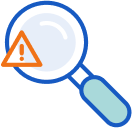It all starts with detection.
The earlier we detect dementia, the better. It helps with getting on the right track for evidenced-based care: timely medical interventions, personalized care plans, and supporting caregivers. And it allows us to start brain health interventions that slow the progression of dementia as early as possible.
Screening, or a brain health check, with your older patients every year can be simple. Scroll down to see a step-by-step approach for detection.
The foundation is understanding your patient’s cognitive and functional status. Are there any signs of cognitive decline or functional decline from a previous baseline? Those two elements are the core components of a dementia diagnosis. Another foundational aspect of care is knowing if there is a caregiver, how they support the person with dementia, and their needs as a caregiver.
Steps for screening
Screen adults 65 and older who do not already have a diagnosis of dementia and who are not on hospice.
Use an approach that quickly assesses cognition, function, and caregiver support. One example is called the “cognitive health assessment”, which has 3 steps:
- Ask about symptoms or review signs of cognitive decline in the last year.
-
Do a brief test on cognition and function. An informant can complete all or part of this assessment. Examples:
Example 1- A Mini-Cog and an ADL/IADL checklist with the patient.
Example 2- A GP-COG page 1 with the patient and GP-COG page 2 done with an informant.
There is information on Dementia Care Aware's Tips to Adjust the Cognitive Health Assessment on how to adapt assessments to a patient's needs, such as language consideration, sensory loss, and educational level.
- Ask if there is a caregiver and document their role.
Disclosure: Inform your patient of the results of their screen.
Example: "On this brief evaluation, there were some signs that you may be having changes in your {thinking/ability to take care of daily tasks}. Let's make a brain health plan and follow-up soon to keep looking into this."
Plan follow-up:
- If a patient has a positive screen, then plan a follow-up appointment to go further in their evaluation and start a brain health plan. See Diagnosis for next steps.
- If a patient has a negative screen, then plan to screen again next year.
Increasingly, there is evidence of the benefits of early interventions, such as increased social activity and correcting hearing. If a patient has a positive screen, there are steps you can take to support brain health:
-
Assess and correct hearing and vision.
-
Encourage physical and social activity.
-
Remove any medications that can affect cognition (for example, sedative-hypnotics and anticholinergics).
-
One tool, the ACBcalc.com, can quantify cholinergic burden with a particular medication regimen.
-
-
Optimize their lipid, hypertension, and diabetes management.
See this summary. And here are additional resources from Dementia Care Aware and the Brain Health Toolkit on how to create a brain health plan.

Did you know?
Correcting hearing loss can prevent dementia and help slow cognitive decline by 30%.
The sooner we detect cognitive symptoms, the sooner we can prioritize hearing.

